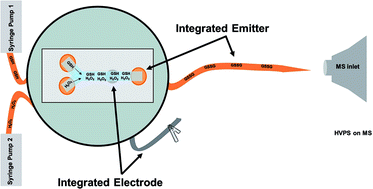Integrated electrodes and electrospray emitter for polymer microfluidic nanospray–MS interface†
Abstract
Interfacing of microfluidic devices to mass spectrometry has challenges including dilution from sheath liquid junctions, fragile electrodes, and excessive dead volumes which prevent optimum performance and common use. The goal of this work is to develop a stable nanospray chip–MS interface that contains easily integrated electrodes and an embedded capillary emitter to mitigate current chip–MS problems. This system uses a hybrid polystyrene–poly(dimethylsiloxane) (PS–PDMS) microfluidic platform with an embedded electrode and integrated capillary emitter used as the nanospray interface. Two chip designs were used to evaluate the performance, and illustrate on-chip reaction capabilities. By direct infusion, this system showed good performance with LODs of glutathione (GSH) and caffeine of 9 nM and 1 nM, R2 of 0.996 and 0.992 and sensitivity of 12 counts per nM and 332 counts per nM over a linear dynamic range of 40 nM to 50 μm and 1 to 50 μm respectively. A reaction was performed on the chip with syringe pumps showing the oxidation of glutathione (GSH) to oxidized glutathione (GSSG) using H2O2. The on-chip reaction of GSH oxidation to GSSG, with online-MS detection, successfully demonstrates the stability and robustness of the nanospray interface.

- This article is part of the themed collection: Microfluidics Research 2015-2016

 Please wait while we load your content...
Please wait while we load your content...